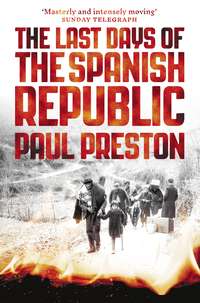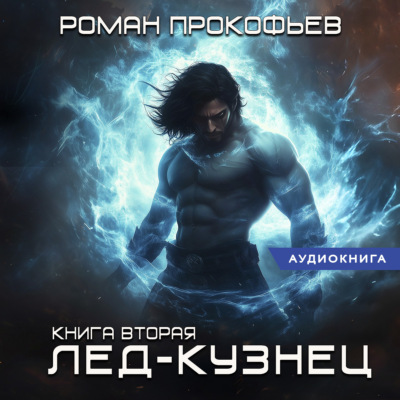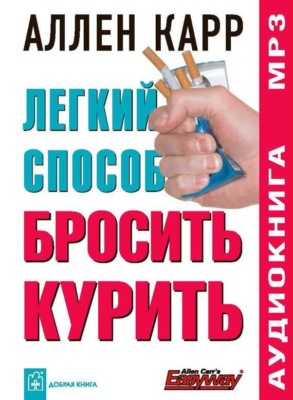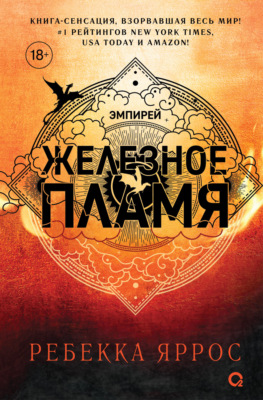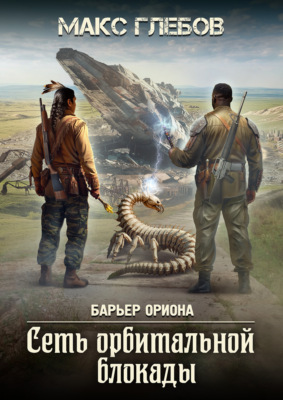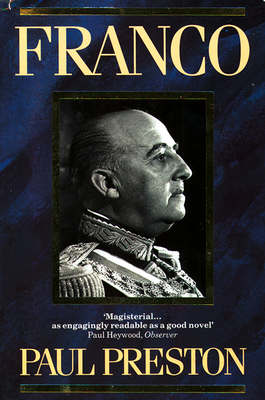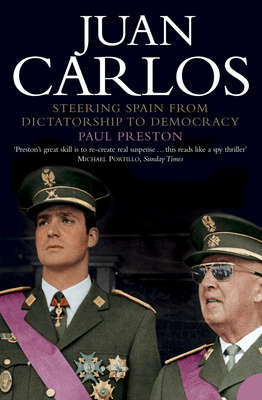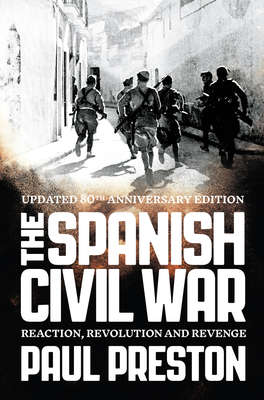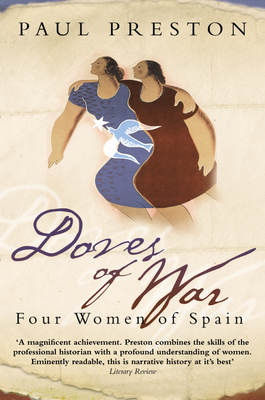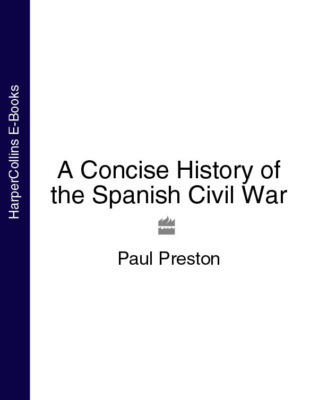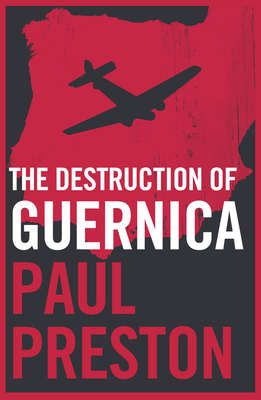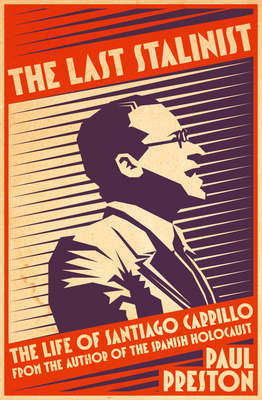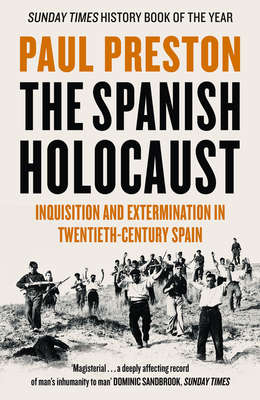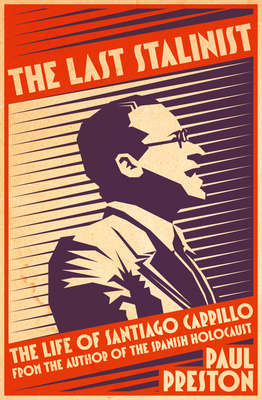Czytaj książkę: «The Last Days of the Spanish Republic»

COPYRIGHT
William Collins
An imprint of HarperCollins Publishers
1 London Bridge Street
London SE1 9GF
First published in Great Britain by William Collins in 2016
Copyright © Paul Preston 2016
Paul Preston asserts his moral right to
be identified as the author of this work
A catalogue record for this book is
available from the British Library
Cover image © Photo12/L’Illustration
All rights reserved under International and Pan-American Copyright Conventions. By payment of the required fees, you have been granted the non-exclusive, non-transferable right to access and read the text of this e-book on-screen. No part of this text may be reproduced, transmitted, down-loaded, decompiled, reverse engineered, or stored in or introduced into any information storage and retrieval system, in any form or by any means, whether electronic or mechanical, now known or hereinafter invented, without the express written permission of HarperCollins.
Source ISBN: 9780008163419
Ebook Edition © February 2016 ISBN: 9780008163426
Version: 2017-03-03
DEDICATION
For Lala Isla
CONTENTS
Cover
Title Page
Copyright
Dedication
Acknowledgements
1 An Avoidable Tragedy
2 Resist to Survive
3 The Power of Exhaustion
4 The Quest for an Honourable Peace
5 Casado Sows the Wind
6 Negrín Abandoned
7 In the Kingdom of the Blind
8 On the Eve of Catastrophe
9 The Desertion of the Fleet
10 The Coup – the Stab in the Back
11 Casado’s Civil War
12 Casado Reaps the Whirlwind
Epilogue: Repent at Leisure?
Picture Section
Abbreviations
Notes
Illustration Credits
Bibliography
Index
By the Same Author
About the Author
About the Publisher
ACKNOWLEDGEMENTS
In the course of preparing this book, I have had the good fortune to rely on the advice on various issues of the following friends and colleagues. Michael Alpert, Javier Cervera, Robert Coale, Alfonso Domingo, Luis Español Bouché, Xulio García Bilbao, Carmen Gonzalez Martinez, Fernando Hernández Sánchez, Eladi Mainar Cabanas, Ricardo Miralles, Enrique Moradiellos, Óscar Rodríguez Barreiro, Cristina Rodríguez Gutiérrez, Sandra Souto and Julián Vadillo.
I am extremely grateful to the following friends for their help in the location of archival material. Laura Díaz Herrera for her invaluable help in Madrid and Ávila; Ángeles Egido León, José Manuel Vidal Zapater and Luis Vidal Zapater for permitting access to the unpublished memoirs of José Manuel Vidal Zapater; María Jesús González Hernández for help with the Causa General. Aurelio Martín Nájera as so often in the past was immensely generous in helping me with documents held in the Archivo Histórico of the Fundación Pablo Iglesias. Sir George Young and Lady Young kindly granted permission for the use of the papers of Sir George Young. My greatest debt is to Carmen Negrín and Sergio Millares Cantero for their unstinting assistance with both the papers and the photographs held in the Fundación Juan Negrín of Las Palmas.
I also want to put on record my thanks to Jesús Navarro, Juan Carlos Escandell and José Ramón Valero Escandell for an unforgettable day spent exploring ‘Posición Yuste’ (El Poblet), the houses at ‘Posición Dakar’ and the airfield (now a vineyard) of El Fondò in Monòver. Professor Valero Escandell also generously provided maps and photographs of the area of the Val de Vinalopó.
The gestation of this book, as with others in the past, was made especially rewarding thanks to my good fortune in being able to discuss many points of fact and of interpretation with my friends Helen Graham, Linda Palfreeman and Ángel Viñas.
1
An Avoidable Tragedy
This is the story of an avoidable humanitarian tragedy that cost many thousands of lives and ruined tens of thousands more. It has many protagonists but centres on three individuals. One, Dr Juan Negrín, the victim of what might be termed a conspiracy of dunces, tried to prevent it. Two bore responsibility for what transpired. One of those, Julián Besteiro, behaved with culpable naivety. The other, Segismundo Casado, behaved with a remarkable combination of cynicism, arrogance and selfishness.
On 5 March 1939, the eternally malcontent Colonel Casado, since May the previous year commander of the Republican Army of the Centre, launched a military coup against the government of Juan Negrín. Ironically, he thereby ensured that the end of the Spanish Civil War was almost identical to its beginning. As General Emilio Mola, the organizer of the military coup of 1936, its future leader General Francisco Franco and the other conspirators had done, Casado led a part of the Republican Army in revolt against the Republican government. He claimed, as they had done, and equally without foundation, that Negrín’s government was the puppet of the Spanish Communist Party (Partido Comunista de España, or PCE) and that a coup was imminent to establish a Communist dictatorship. The same accusation was made by the anarchist José García Pradas, who talked of Negrín personally leading a Communist coup.1 In that regard, it is worth recalling the judgement of the great American war correspondent Herbert Matthews, who knew Negrín well:
Negrín was neither a Communist nor a revolutionary … I do not believe that Negrín gave the idea of a social revolution any thought before the Civil War … Negrín retained all his life a certain indifference and blindness to social issues. Paradoxically, this put him in agreement with the Communists in the Civil War. He was equally blind in an ideological sense. He was a prewar Socialist in name only. Russia was the only nation that helped Republican Spain; the Spanish Communists were among the best and most disciplined soldiers; the International Brigade, with its Communist leadership, was invaluable. Therefore, Premier Negrín worked with the Russians, but never succumbed to or took orders from them.2
A not unsimilar view was expressed by Negrín’s lifelong friend Dr Marcelina Pascua:
Was Negrín a Communist? How ridiculous! Not by a thousand miles. He was congenitally individualistic, utterly disinclined to follow a collective discipline or to put up with tight rules and regulations imposed by a political party or to follow the personal requirements that the instruments of marxism impose on their adherents. As far as any hero worship was concerned, the person that he admired most was Clemenceau (and not his contemporary Lenin) despite being fully aware of his repressive and reactionary policies against the trade unions and his persistent hostility to the French Socialists. I always interpreted Negrín’s veneration for ‘the Tiger’ in terms of his being seduced by the energy and efficacy that he demonstrated during the First World War. This explains the contradiction because what Negrín admired in Clemenceau was exactly the pragmatic determination to win the war that was what he aspired to do in the Spanish conflict.
According to Pascua, Negrín adopted as a private slogan Clemenceau’s remark that ‘Dans la guerre comme dans la paix le dernier mot est à ceux que ne se rendent jamais.’3
Casado claimed that he launched his coup because he was sure that he could put a stop to what was increasingly senseless slaughter and that he could secure the clemency of Franco for all but the Communists. Even if this was genuinely his selfless motive, and there is ample evidence to the contrary, he went about it in the worst way imaginable. In his dealings with Franco, he behaved as if he had nothing to bargain with. He seemed to be oblivious of the fact that Franco was obsessed with capturing Madrid, the very symbol of resistance. The Caudillo had failed to do so in November 1936 and had also been thwarted at the battles of Jarama and Brunete in February and July 1937. Unlike Negrín, who could threaten continued resistance when Franco was being pushed by his German and Italian allies for an early end to the war, Casado took the position that the war was already lost. His only hope therefore was the naive, and rather arrogant, belief that Franco would be susceptible to a vague rhetoric of shared patriotism and the fraternal spirit of the wider military family, as if somehow they were equals.4 In consequence, his action would actually cause massive loss of life.
It is certainly the case that the defeat of the Spanish Republic was already in sight. What remained possible, however, was to ensure that the war ended in such a way as to secure the evacuation of the most at-risk politicians and soldiers and guarantees for the civilian population to be left behind. As Negrín had commented to Juan-Simeón Vidarte of the executive committee of the Spanish Socialist Party (Partido Socialista Obrero Español, or PSOE): ‘A negotiated peace, always; unconditional surrender to let them shoot half a million Spaniards, never.’5 Ernest Hemingway summed up Negrín’s position as follows: ‘In a war you can never admit, even to yourself, that it is lost. Because when you will admit it is lost you are beaten. The one who being beaten refuses to admit and fights on the longest wins in all finish fights; unless of course he is killed, starved out, deprived of weapons or betrayed. All of these things happened to the Spanish people. They were killed in vast numbers, starved out, deprived of weapons and betrayed.’6 With the Spanish Republic exhausted and internationally isolated, Casado’s fateful initiative merely precipitated its defeat in the worst imaginable conditions. His revolt against the Republican government sparked off a mini-civil war in Madrid, ensuring the deaths of 2,000 people, mainly Communists, and undermined the evacuation plans for hundreds of thousands of other Republicans.7
It has been suggested that what happened was the consequence of the ‘fact’ that Casado was a British agent. It is unlikely that he was an ‘agent’ or even in receipt of payment, but he was certainly in touch with British representatives – the Chargé d’Affaires Ralph Skrine Stevenson and Howard Denys Russell Cowan of the Chetwode Commission, which was trying to arrange prisoner exchanges. Given that the British government had long assumed that the Republic would be defeated, and wished to be free of what was seen as an unnecessary problem, there can be little doubt that Stevenson and Cowan at the very least encouraged Casado in his efforts to end the war. The ex-Communist Francisco-Félix Montiel claimed that ‘London was behind Casado.’8 At the end of February 1939, Casado met some Communist officers at his headquarters on the eastern outskirts of Madrid, given the military codename ‘Posición Jaca’. Completely out of context, he assured them that ‘the rumours that he was an agent of British intelligence were not true and it was not at his initiative that members of the British Embassy visited him and showered him with attention’.9 Within Negrín’s entourage there was a belief in British involvement in the coup. In 1962, the American journalist Jay Allen wrote to another newspaperman Louis Fischer, both friends of Negrín, ‘Who, besides Rafael Méndez, whose address I don’t have, could fill me in on the role of the British Intelligence agent who helped pull off the Casado coup?’10
Casado was born on 10 October 1893 in Nava de la Asunción in the province of Segovia. He was brought up under the strict discipline imposed by his father, an infantry captain, and became an officer cadet himself at the age of fifteen. He graduated as a first lieutenant in 1920 and made his career as a desk officer, albeit a very competent one. Apart from a brief and relatively tranquil eight-month period in Morocco, he had no battlefield experience. He had no political links, although in January 1935 he was appointed head of the presidential escort of Niceto Alcalá Zamora, whom he admired. After Alcalá had been replaced by Manuel Azaña in May 1936, Casado, who had reached the rank of major, found the post much less agreeable. In August 1936, he resigned from the presidential guard on the grounds that working with Azaña was ‘a horrible torture’. Promoted to lieutenant colonel, he then became chief of operations of the general staff when Francisco Largo Caballero became Prime Minister and Minister of Defence. When Vicente Rojo was made chief of staff, a promotion that Casado never forgave since he aspired to the post himself, he became inspector general of the cavalry but deeply resented Rojo and the Communists. His battlefield experiences at Brunete in July and Zaragoza in October 1937 were not crowned with success. Nevertheless, in 1938, by now promoted to full colonel, he was given two important posts, as head of the Army of Andalusia and shortly afterwards as head of the Army of the Centre.11 He seems to have held an extremely cordial meeting with the PCE top brass in Madrid on 25 July 1938. One of the topics discussed was how, in the event of Republican defeat, a staged evacuation might be mounted. Francisco-Félix Montiel claimed later that the purpose of this meeting was for the PCE to ensure that an incompetent traitor was in place to bring the war to an end in such a way as to absolve the party of responsibility. In fact, it is much more likely that the purpose of the meeting was to ensure the loyalty of Casado and the Army of the Centre just as the Republican army was crossing the Ebro, in the last great push for victory. If the Communists doubted Casado’s loyalty, Rojo doubted his competence.12
Casado was an irascible officer noted for his rectitude and austerity. In fact, his evil temper and his ascetic way of life were to some extent explained by the painful stomach ulcers from which he suffered. When the vice-president of the Socialist General Union of Workers (Unión General de Trabajadores, or UGT), Edmundo Domínguez Aragonés, was appointed commissar inspector of the Army of the Centre at the end of December 1938, he went to introduce himself to Casado. He found him prostrate on his bed. Casado’s unprovoked and gratuitous assertions of loyalty rang alarm bells: ‘I am a soldier whose only duty is to respect and obey the Government. You can see just how committed I am to this duty because anyone else in my situation, with an ulcer tearing through his guts, would have ample excuse to abandon it all and look after his health. Not me. Madrid has been entrusted to me and I will defend it or die trying. If I left, they would say that I am a coward.’ Domínguez was struck by the way in which, ‘emanating self-satisfaction’, Casado vehemently asserted that his principal concern was to alleviate the suffering of the women and children of the capital. Far from being convinced, Domínguez’s suspicions were aroused that Casado was insincere and trying to hide something.13
Fernando Rodríguez Miaja, the nephew and private secretary of General José Miaja, the erstwhile hero of the defence of Madrid, had similar doubts about Casado: ‘Intelligent and a technically a good soldier, Casado was ambitious, self-obsessed and histrionic with a bitter and unpleasant character … He had an uncontrollable desire to be always pre-eminent, in the limelight and centre-stage. He lived and behaved only in the first person singular. These characteristics of his personality had a great bearing on the way the Spanish war ended.’14
It is certainly the case that his behaviour during the last months of the Spanish Civil War suggest a self-serving arrogance which fed the ambition to go down in history as the man who ended the war. This was brazenly revealed in the dedication (to M.O.) of the memoir written shortly after his arrival in London in 1939. He wrote sarcastically: ‘I left my country because I committed the grave fault of ending a fratricidal struggle, sparing my people much sterile bloodshed.’ He went on to comment on the historical transcendence of his actions.15 While still in Spain he had told Dr Diego Medina Garijo, his personal physician and a member of the Francoist Fifth Column, that it was his intention to astound the world.16 This rather sustains the judgement of Vicente Rojo that Casado was a vacuous and sinister megalomaniac: ‘Casado is all talk. Casado does not serve the people and he never has. He is the most political and most crooked and fainthearted of the career officers in the Republican ranks.’17 Even more caustic was the opinion of Dolores Ibárruri, the Communist orator famed as ‘Pasionaria’: ‘It is difficult to conceive of more slippery and cowardly vermin than Colonel Segismundo Casado.’18
The bitterness of Pasionaria is comprehensible, given that the Communists would be among the most immediate victims of Casado’s coup. Less partisan perhaps is the view of his collaborator, General Miaja, who referred to him in private as ‘four-faced’ on the grounds that to call him ‘two-faced’ would barely reflect the reality.19 More intriguing is the contemptuous judgement of Antonio Bouthelier España, a member of the fascist party Falange Española and one of Casado’s contacts with the Fifth Column. He described Casado as ‘a soldier who did not feel pride in his profession, who did not understand the word “service”, restless and ambitious, envious of politicians in top hat and frock coat, author of long-winded and solemn speeches … an eternal malcontent who acted only in his own interests’.20
In a real sense, there was an inevitability about the eventual defeat of the Republic. The initial military rising took place on the evening of 17 July 1936 in Spain’s Moroccan colony and in the peninsula itself the next morning. The plotters were confident that it would all be over in a few days. Their coup was successful in the Catholic smallholding areas which voted for the right – the provincial capitals of rural León and Old Castile, cathedral market towns like Avila, Burgos, Salamanca and Valladolid. However, in the left-wing strongholds of industrial Spain and the great estates of the deep south, the uprising was defeated by the spontaneous action of the working-class organizations. Nevertheless, in major southern towns like Cadiz, Cordoba, Granada and Seville, left-wing resistance was soon savagely crushed.
Within days, the country was split into two war zones. The rebels controlled one-third of Spain in a northern block of Galicia, León, Old Castile, Aragon and part of Extremadura and an Andalusian triangle from Huelva to Seville to Cordoba. They had the great wheat-growing areas, but the main industrial – and food-consuming – centres remained in Republican hands. After vain efforts to reach a compromise with the rebels, a cabinet of moderate Republicans was formed under the chemistry professor José Giral. There was some reason to suppose that the Republic would be able to crush the rising. Giral’s moderate Republican cabinet had control of the nation’s gold and currency reserves and virtually all of Spain’s industrial capacity. However, it lacked a loyal functioning bureaucratic machinery, especially in the fields of public order and the economy.
There were three major advantages enjoyed by the military rebels that would eventually decide the conflict – the African Army, massive assistance from the fascist powers and the tacit support of the Western democracies. Republican warships were able for only three weeks to prevent the transportation from Morocco to Spain of the rebels’ strongest card, the ferocious colonial army under Franco. Moreover, the fact that power in the streets of Spain’s major cities lay with the unions and their militia organizations undermined the efforts of Giral’s government to secure aid from the Western democracies. Inhibited by internal political divisions and sharing the British fear of revolution and of provoking a general war, the French premier Léon Blum quickly drew back from early promises of aid. In contrast, Franco in North Africa was able to persuade the local representatives of Nazi Germany and Fascist Italy that he was the man to back. By the end of July, Junkers 52 and Savoia-Marchetti 81 transport aircraft were starting to airlift the principal components of the Army of Africa, the bloodthirsty Foreign Legion and the Moroccan mercenaries of the so-called Native Regulars, across the Strait of Gibraltar to Seville. Fifteen thousand men crossed in ten days and a failed coup d’état became a long and bloody civil war. That crucial early aid was soon followed by a regular stream of high-technology assistance. In contrast to the state-of-the-art equipment arriving from Germany and Italy, complete with technicians, spare parts and the correct workshop manuals, the Republic, shunned by the democracies, had to make do with over-priced and obsolete equipment from private arms dealers.
The rebels swiftly undertook two campaigns that dramatically improved their situation. Mola attacked the Basque province of Guipúzcoa, cutting it off from France. Meanwhile, Franco’s Army of Africa advanced rapidly northwards to Madrid, leaving an horrific trail of slaughter in their wake, including the massacre at Badajoz where 2,000 prisoners were shot. By 10 August, they had united the two halves of rebel Spain. The rebels consolidated their position throughout August and September as General José Enrique Varela connected Seville, Cordoba, Granada and Cadiz. For the Republicans, there were no spectacular advances, only retreats and two frustrating operations – the siege of the rebel garrison of Toledo in the fortress of the Alcázar and the futile attempt of anarchist militia columns from Barcelona to recapture Zaragoza, which had fallen quickly to the rebels.
The Spanish Republic was fighting not only Franco and his armies but increasingly also the military and economic might of Hitler and Mussolini. Snubbed by France and Britain, the Republican premier, Giral, turned to Moscow. The initial reaction of the Soviet Union was one of deep embarrassment. The Kremlin did not want the events in Spain to undermine its delicately laid plans for an alliance with France. However, by mid-August, the flow of help to the rebels from Hitler and Mussolini threatened an even greater disaster if the Spanish Republic fell. That would severely alter the European balance of power, leaving France with three hostile fascist states on its borders. Stalin’s reluctant decision to aid Spain was thus based on raison d’état. Distance and organizational chaos meant that it was mid-September before the transportation of any equipment to Spain. The first shipment of ancient rifles and machine guns arrived on 4 October. Only at the end of September, after the Republic had agreed to send its gold reserves to Russia, was the decision taken to send modern aircraft and tanks – which had to be paid for at inflated prices.
In the meantime, the all-Republican cabinet of Professor Giral had given way to a more representative government of Republicans, Socialists and Communists under the premiership of the veteran trade unionist Francisco Largo Caballero. Although popular among workers, Largo Caballero lacked the energy, determination and vision to direct a successful war effort. He failed to see that an effective war effort required a centralized state apparatus.21 While the Republic floundered in search of foreign assistance and its disorganized militias fell back on the capital, the rebels tightened up their command structure. On 21 September at an airfield near Salamanca, the leading rebel generals met to choose a commander-in-chief both for obvious military reasons and to facilitate relations with Hitler and Mussolini. Already enjoying good communication with the Führer and the Duce, Franco was their choice. On the same day, Franco decided to divert his columns, now at the gates of Madrid, to the south-east to Toledo. He thus lost an unrepeatable chance to sweep on to the capital before its defences were ready. However, by relieving the Alcázar, he clinched his own power with an emotional victory and a great media coup. He was also able to slow down the pace of the war in order to carry out a thorough political purge of captured territory. On 28 September, he was confirmed as head of the rebel state. Thereafter, he ruled over a tightly centralized zone. In contrast, the Republic was already severely hampered by intense divisions between the Communists, the middle-class Republicans and moderate Socialists on the one hand, who were rebuilding the state apparatus to make a priority of the war effort, and the anarchists, Trotskyists and left Socialists on the other, who wanted to put the emphasis on social revolution.
On 7 October the Army of Africa resumed its march on a Madrid inundated with refugees and beset by major supply problems. In an effort to rally the population, on 4 November, Largo Caballero added two anarcho-syndicalist ministers to his cabinet in the hope of widening popular support for the beleaguered Republic. Franco’s delay permitted the morale of the defenders of Madrid to be boosted by the arrival in early November of aircraft and tanks from the Soviet Union together with the columns of volunteers known as the International Brigades. The siege of Madrid saw heroic efforts by the entire population. On 6 November, expecting the capital to fall quickly, the government fled to Valencia. The city was left in the hands of General José Miaja. Backed by the Communist-dominated Junta de Defensa, the unkempt Miaja rallied the population while his brilliant chief of staff, Colonel Vicente Rojo, organized the city’s forces. The first units of the International Brigades reached Madrid on 8 November, and consisted of German and Italian anti-fascists, plus some British, French and Polish left-wingers. Sprinkled among the Spanish defenders at the rate of one to four, the brigadiers both boosted their morale and trained them in the use of machine guns, in the conservation of ammunition and in the methods of using cover. They successfully resisted Franco’s African columns and, by late November, he had to acknowledge his failure. The besieged capital would hold out for another two and a half years until the fateful sequence of events triggered by Colonel Casado.
The arrival of Russian equipment and international volunteers in the autumn helped save Madrid. However, their presence was also to be used by Franco’s sympathizers to justify the intervention of Hitler and Mussolini and inhibit the Western powers. The motivation of both Germany and Italy was principally to undermine the Anglo-French hegemony in international relations, yet both dictators received a sympathetic ear in London when they claimed to be in Spain to combat bolshevism. Besieged, the Republic also had complex internal problems unknown in Franco’s brutally militarized zone. The collapse of the bourgeois state in the first days of the war had seen the rapid emergence of revolutionary organs of parallel power – the committees and militias linked to the left-wing unions and parties. A massive popular collectivization of agriculture and industry took place. Exhilarating to participants and foreign observers like George Orwell, the great collectivist experiments of the autumn of 1936 were an obstacle to the creation of a war machine. Opposing beliefs about whether to give priority to war or revolution would lie at the heart of the internal conflict that raged within the Republican zone until mid-1937. The Republican President, Manuel Azaña, and moderate Socialist leaders like the Minister of the Navy and Air Force, Indalecio Prieto, and the Minister of Finance, Juan Negrín, were convinced that a conventional state apparatus, with central control of the economy and the institutional instruments of mass mobilization, was essential for an efficacious war effort. The Communists and the Soviet advisers agreed – it made sense and they hoped that halting the revolutionary activities of Trotskyists and anarchists would reassure the bourgeois democracies being courted by the Soviet Union.
Preoccupied by internal dissensions, and still without a conventional army, the Republic was unable to capitalize on its victory at Madrid. Franco’s immediate response was a series of attempts to encircle the capital. At the battles of Boadilla (December 1936), Jarama (February 1937) and Guadalajara (March 1937), his forces were beaten back, but at enormous cost to the Republic. Concentration on the defence of Madrid meant the neglect of other fronts. Málaga in the south fell to newly arrived Italian troops at the beginning of February. The war in central Spain saw no easy victories. At Jarama, the rebel front advanced a few kilometres, but made no strategic gain. The Republicans lost 25,000 men, including some of the best British and American members of the Brigades, and the rebels about 20,000. In March, the rebels made further efforts to encircle Madrid by attacking near Guadalajara, 60 kilometres north-east of Madrid. An army of 50,000, the best-equipped and most heavily armed force yet seen in the war, broke through, but was defeated by a Republican counter-attack. Thereafter, as the Republic organized its People’s Army (Ejército Popular de la República), the conflict turned into a more conventional war of large-scale manoeuvre.
